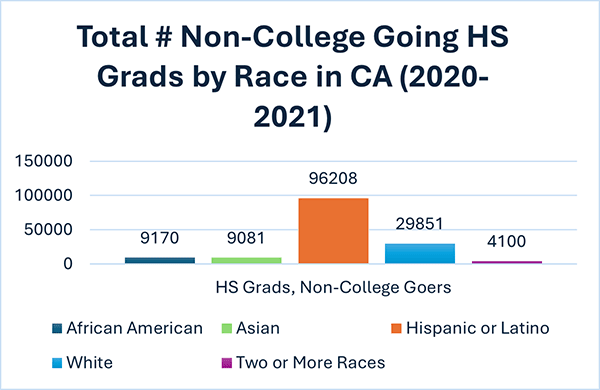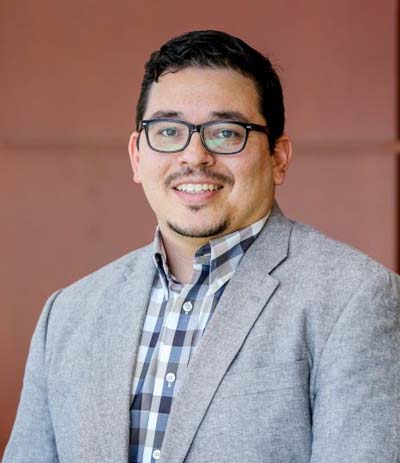California’s Non-College Goers: Latinos Surpass Other Ethnoracial Groups in a Hispanic-Serving State
By Gina Ann Garcia, Ph.D. and Nicholas Vargas, Ph.D.
Policy Recommendations
- California HSIs should include outreach and recruitment in their federally funded HSI efforts.
- California 4-year HSIs should develop partnerships with high schools to ensure that Latino students are college-ready immediately after graduation.
- California HSIs should communicate with Latino families and communities in Spanish and other heritage languages (i.e., indigenous languages).
- The state of California should develop legislation to specifically help HSIs recruit Latino students.
Introduction

The state of California graduates nearly half a million high school students each year. These graduates can attend approximately 150 state colleges including the California Community Colleges (CCC), California State University (CSU), and University of California (UC) systems. There are also roughly 150 private nonprofit institutions and 160 private for-profit institutions in California[1]. These options provide the state’s high school graduates with numerous possibilities for pursuing postsecondary education. Yet, many California high school graduates are not enrolling in college. In 2021, there were 435,202 high school graduates, yet only 249,248 enrolled in California colleges and universities (about 57%)[2]. Although another 8% enrolled in postsecondary institutions outside of California, the majority who decided to attend college enrolled in state, while 35% did not enroll in a college within 16 months of their graduation (i.e., non-college goers).

Notably, the largest ethnoracial group graduating from California high schools is Latinos, representing 52.7% of those who finished in 2021. Yet their college going rate in California colleges and universities is only 58%, substantially lower than their Asian (87.6%) and White (71.4%) counterparts, for example. In 2021, there were roughly 100,000 non-college going Latino high school graduates, ten times as many as their Asian and African American peers. These differences along ethnoracial lines are stark. In fact, in 2021 there were far more Latino students who graduated high school but did not enroll in college (96,208) than the total number of newly enrolled students in all UC and CSU campuses combined (85,054).
California is a Hispanic-Serving Institution State
The college-going enrollment patterns show that a majority of California high school graduates attend college at one of the three public systems (CCC, CSU, UC). These three public systems are notably Hispanic-serving systems, as most of the campuses in each are eligible Hispanic-Serving Institutions (HSIs). HSIs are non-profit postsecondary institutions that enroll at least 25% full-time equivalent enrollment of Hispanic/Latino students. Eligibility is determined by the federal government based on enrollment data and enables HSIs to apply for federal funding earmarked for these institutions. In fall 2021, there were 170 HSIs in California, including 107 of the CCCs, 21 of the CSUs, 5 of the UCs, and 37 private nonprofit institutions. As a collective, HSIs play an important role in providing access to Latino high school graduates, with 62% of all Latino students in the United States attending an HSI[3]. Yet there are still debates about whether HSIs are simply enrolling Latinos or actually serving them, as their federal eligibility suggests. Garcia and colleagues proposed a servingness framework to help practitioners and researchers operationalize the “s” in HSIs, and to push educators to do more than enroll a large percentage of Latino students[4].
Yet the framework does not account for pre-enrollment activities such as recruitment and outreach of Latino students or P-20 partnerships that may enhance the enrollment of Latino high school graduates. Considering the high number of Latino non-college goers in California, HSIs should account for their pre-enrollment activities as part of their servingness efforts. Guests on the popular podcast ¿Qué pasa, HSIs? have talked about how they are working with enrollment management offices, engaging in Spanish outreach and recruitment activities, and intentionally working with undocumented students to ensure they have access to financial aid and support for college[5]. These are a few efforts that California HSIs can engage in as they think about their role in serving Latino students prior to college enrollment.
Recent reports show that 56% of California high school graduates in 2023 were not even eligible to apply for the state’s institutions as they did not complete their A-G requirements[6]. Ensuring that the state’s Latino high school graduates can enroll in college should be a high priority for California HSIs, and even higher priority for the states campuses that are actively striving to become HSIs including UC Berkeley, UCLA, and UC San Diego. Waiting for Latino students to enroll is not servingness; there must be proactive engagement with potential Latino students. Moreover, with 59% of Latino college goers in California enrolled in community colleges in 2021, four-year HSIs must focus on successful transfer as an indicator of serving Latino students.
Why Does it Matter?
Roughly 150,000 students who graduated from California high schools in 2021 were not enrolled in college 16 months later. Should these trends continue, there will be nearly 1.5 million high school graduates in the state with no college experience by 2031, roughly 1 million of whom will be Latinos. This should be a concern to the state. California’s labor market is becoming increasingly competitive, with college educated workers faring better than those with no post-secondary college experience. For example, in 2021, workers with a bachelor’s degree earned 62% more than those with a high school diploma[7]. College educated workers are also more likely to have a retirement plan and paid vacations. A college educated work force is also good for California as those with a college degree are more likely to be employed, more likely to have health insurance, more likely to be civically engaged, and more likely to vote in local elections, all of which benefit the state overall.
CRB Nexus guest authors

Dr. Gina Ann Garcia is a professor in the School of Education at UC Berkeley. Her research centers on issues of equity and justice in higher education with an emphasis on understanding how Hispanic Serving Institutions (HSIs) embrace and enact an organizational identity for serving minoritized populations. HSIs are colleges and universities that enroll at least 25% Latino students. California is now home to 170 HSIs, with all three state CA systems becoming HSI systems within the next 3-5 years. Her work directly connects to policy in that HSI is a federal designation enacted through the Higher Education Act, with her research calling for more accountability for serving Latino and racially minoritized students. Dr. Garcia is the author of Becoming Hispanic-Serving Institutions: Opportunities for Colleges & Universities and the editor of the book Hispanic-Serving Institutions in Practice: Defining “Servingness” at HSIs. Her newest book, Transforming Hispanic Serving Institutions for Equity and Justice was released in Spring 2023 and is now available. She also hosts a popular podcast called, ¿Qué Pasa, HSIs?

Nicholas Vargas is an Associate Professor in the Department Ethnic Studies at the University of California, Berkeley. He is co-leader of the Latinos and Democracy Cluster initiative at UCB and serve as Faculty Co-Director of the UCB Latino Social Science Pipeline Initiative (LSSPPI), both of which aim to advance Latino social science scholarship and strengthen academic pipelines. His research is situated primarily in the social sciences with foci on ethnoracial classification, identification, and stratification. Most of his scholarship draws from nationally representative data and explores questions of ethnoracial boundaries, patterns of label use, racial ideology adherence, contested racial identity, and Latino experiences in higher education with particular attention paid to various organizational and individual markers of racialization. Methodologically, his core aim is to think critically about the utility of race data for identifying and rectifying societal, systemic, and structural racisms. He currently serves on the National Advisory Committee of the U.S. Census Bureau, as Associate Editor of the journal Sociology of Race and Ethnicity, and as Past-Chair of the American Sociological Association’s Section on Racial and Ethnic Minorities. Prior to UCB, he was Coordinator of Latino Studies at the University of Florida’s (UF) Center for Latin American Studies, Associate Professor of Sociology at UF, and Assistant Professor in the School of Economic, Political, and Policy Sciences at the University of Texas at Dallas.
